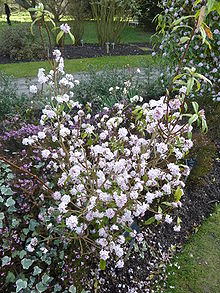- Daphne bholua
-
Daphne bholua 
Daphne bholua 'Jacqueline Postill' Scientific classification Kingdom: Plantae Division: Angiosperms Class: Monocots Order: Malvales Family: Thymelaeaceae Genus: Daphne Species: D. bholua Binomial name Daphne bholua
Buch.-Ham. ex D. Don[1]Daphne bholua is a flowering shrub in the genus Daphne. It grows at altitudes of 1700–3500 m in the Himalayas and neighbouring mountain ranges, from Nepal to southern China. At lower altitudes it is found as an evergreen in thickets and forest margins; at higher altitudes, it is deciduous and is usually found in pastures and grassy glades.[2] It usually reaches a height of about 2.5 m, though some specimens reach 4 m or more.[3]
Daphne bholua produces flowers with a powerful fragrance,[2] and a number of named cultivars have been bred and are grown as garden plants in Europe and North America.
Contents
Range
D. bholua has a wide range in the Himalayas and adjoining ranges, from Nepal through Bhutan, Bangladesh, Myanmar and Vietnam, into Sichuan and north-west Yunnan.[3]
In Nepal, the plant's common name is "baruwa"; in Tibet it is "chu chu".[4]
Uses
D. bohlua is one of a number of species of Daphne that are used in traditional paper-making in Nepal,[5][6] hence its common English name of "paper daphne".[7]
The inner bark also yields a fibre that is used to make rope.[6]
Although all parts of the plant are said to be poisonous,[8] the bark and roots are used in traditional medicine in Nepal to treat fevers.[4][6]
Horticulture
Requirements
Most cultivars of Daphne bholua will grow in alkaline or acidic soils, though shallow chalky soils and light sandy soils, which dry out in hot weather, are unsuitable: a steady supply of moisture is essential during the growing season. A position that is sheltered both from the full sun and from strong winds is preferred.[9]
Propagation
Because cultivated varieties of D bholua flower in winter, they tend not to produce much seed,[6] and the seed has a short period of viability,[9] so must be sown soon after collection, under gentle heat. Germination is usually complete within six to eight weeks. Plants sown from seed produce their first flowers after three or four years.
Most cultivars are difficult to propagate from cutting, being slow to root and to establish:[7] D. bholua f. alba and D. bohlua 'Darjeeling' are reported to be the easiest cultivars to propagate from cuttings.[7][9]
In view of the difficulties of growing from seed or cuttings, cultivars have traditionally been propagated by grafting cuttings onto the rootstock of a related species, usually D. longilobata or D. mezereum, which are more easily grown from seed. Even this is not reliable: plants that have grown well for eight to ten years may die suddenly when the root system collapses.[7]
In recent years, some cultivars have been multiplied by micropropagation. Micropropagated plants produce suckers, like the wild species, so that even if the main stem dies, the suckers ensure that the plant will continue to flourish.[7]
Cultivars
Among the more popular cultivars are:
- D. bholua var. gracilis 'Ghurka' — this variety was collected as seed on the Milke Danda ridge, Nepal, at around 3200 m; it is particularly tolerant of low temperatures, becoming deciduous at temperatures below about -10°C. 'Ghurka' has a distinctive bright tan bark, with mauve-purple buds that open to pale pink flowers; it flowers between January and March.[9]
- D. bholua 'Jacqueline Postill' — this was developed from seed of the 'Ghurka' variety. It has similar flowers to its parent, with 12-15 flowers per inflorescence, but is more evergreen and is probably the hardiest evergreen variety in cultivation, for which reason it is the most widely available and most popular cultivar.[9]
- D. bholua 'Darjeeling' — this was developed at the Royal Horticultural Society's gardens at Wisley in the late 1970s; it has a vigorous upright habit and produces white to pale pink buds and flowers, 5 to 15 per infloresescence, between November and January.[9]
- D. bholua 'Peter Smithers' — this variety can be traced to seed collected by Sir Peter Smithers in the Daman Ridge area of Nepal; the buds are dark red-purple and the flowers are pink.[2]
- D. bholua 'Rupina La' — this clone was collected in the Gurkha Himalaya, in central Nepal. A deciduous variety, it has large leaves and larger flowers than other varieties. The flowers are dusky pink, 3.5–4 in diameter, and there may be as many as 25 blooms on a single infloresecence.[9]
References
- ^ Species original description is in Prodromus florae nepalensis, 68 (1825) GRIN (2 October 2008). "Taxon: Daphne bholua Buch.-Ham. ex D. Don". Taxonomy for Plants. National Germplasm Resources Laboratory, Beltsville, Maryland: USDA, ARS, National Genetic Resources Program. http://www.ars-grin.gov/cgi-bin/npgs/html/tax_search.pl. Retrieved 6 July 2010.
- ^ a b c Lancaster, Roy (February 2009). "Himalayan Perfumer". The Garden (Royal Horticultural Society) 134 (2): 106–7.
- ^ a b "Flora of China, vol 13, p 244". http://www.efloras.org/florataxon.aspx?flora_id=2&taxon_id=242421832. Retrieved 6 July 2010.
- ^ a b Manandhar, Narayan P; Manandhar, Sanjay (April 2002). Plants and People of Nepal. Portland, Oregon: Timber Press. pp. 636. ISBN 978-0881925272.
- ^ Trier, Jesper (1972). Ancient paper of Nepal. Copenhagen: Jutland Archaeological Society. pp. 274. ISBN 9788700495517.
- ^ a b c d "Daphne bholua". Plants For A Future. http://www.pfaf.org/database/plants.php?Daphne+bholua. Retrieved 6 July 2010.
- ^ a b c d e Buffin, Michael W. (September 2005). Winter-flowering shrubs. Portland, Oregon: Timber Press. pp. 232. ISBN 9780881927221.
- ^ Cooper, Marion R; Johnson, Anthony W (July 1984). Poisonous Plants in Britain and Their Effects on Animals and Man. HMSO. pp. 319. ISBN 978-0112425298.
- ^ a b c d e f g White, Robin (2006). Daphnes: a practical guide for gardeners. Portland, Oregon: Timber Press. pp. 224. ISBN 978-0881927528.
Categories:- Thymelaeaceae
- Plants described in 1825
- Flora of Nepal
- Flora of China
Wikimedia Foundation. 2010.
